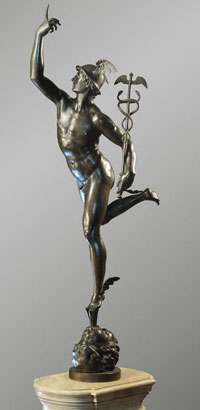| |
|
| |
|
|
|
|
|
|
| |
 |
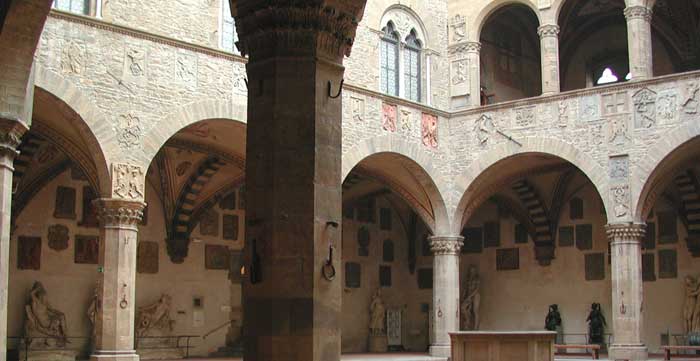 |
|
 |
 |
|
Inner courtyard of the Bargello
|
|
 |
 |
| |
|
|
|
| |
|
Tuscany Travel Guide | Art in Florence | The Bargello Museum
|
|
|
|
| |
|
To get a full idea of the achievement of the Florentine Renaissance, a visit to the Bargello is as important as a day in the Uffizi.
The National Museum has its setting in one of the oldest buildings in Florence that dates back to 1255. Initially the headquarters of the Capitano del Popolo (Captain of the People) and later of the Podestà, the palace became, in the sixteenth century, the residence of the Bargello that is of the head of the police (from which the palace takes its name) and was used as prison during the whole 18th century. Its walls witnessed important episodes of civic history. It was the meeting place of the Council of the Hundred in which Dante took part. It wituessed sieges, fires, executions, the most famous perhaps being that of Baroncelli, involved in the Pazzi plot against the Medici, which Leonardo also witnessed. During the 14th and 15th century, the palace was subjected to a series of alterations and additions, still preserving its harmonious severity, best seen in the beautiful courtyard, the balcony and the large hall on the first floor.
|
The Museum occupies an impressive building built for the Capitano del Popolo in the mid-13th century, which later became the seat of the Podestà and Council of Justice.
The Bargello Museum
Via del Proconsolo, 4, 50122 Firenze
www.polomuseale.firenze.it
Hours
Daily: 8.15-13.50
Closed on the 1st, 3rd and 5th Sunday and 2nd and 4th Monday of each month; New Year’s Day, May 1st and Christmas Day.
Ticket offices close at 13.20
The Museum has a remarkable collection of sculpture and works of art.
The Museum occupies an impressive building built for the Capitano del Popolo in the mid-13th century, which later became the seat of the Podestà and Council of Justice.
Since 1865 the palazzo houses the National Museum, bringing
together many important Renaissance sculptures, including masterpieces by Donatello, Luca della Robbia, Verrocchio, Michelangelo and Cellini. The museum was subsequently enriched with splendid collections of bronzes, majolica, waxes, enamels, medals, seals, ivories, amber, tapestries, furniture and textiles from the Medici collections and those of private donors.
|
|
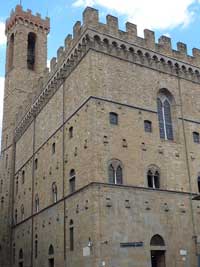
|
The building's use as National Museum began in the mid-19th century. Today it is the setting for works of sculpture, mainly from the grand ducal colleotions, and for many examples of "minor'' Gothic decorative arts.
The large 14th century hall on the first floor displays some works by Donatello (1386-1466) including the early marble David, the St. George moved to this location from the niche in Orsammichele, the more mature and ambiguous bronze David, the Atys. and the Marzocco, originally installed on the battlements of Palazzo Vecchio.
The works of the master are surrounded by the most delicate works of his pupils Desiderio da Settignano (c. 1430-1464) and Antonio Rossellino (c. 1427-1479). The collection also includes the two panels entered by Lorenzo Ghiberti and Filippo Brunelleschi for the Baptistery door competition of 1401. The Renaissance repertoire comprises the glazed terracottas by Luca della Robbia (c.1400 - 1482) that include a very extraordinary group of Madonna with Child.
The rooms on the ground floor exhibit Tuscan 16th century works, focusing in particular on four masterpieces by Michelangelo (1475-1564): Bacchus, the relief representing a Madonna with Child, Brutus and David-Apollo.
The assortment is then followed by works of Andrea Sansovino (14601529), Jacopo Sansovino (1486-1570), Baccio Bandinelli (1488- 1560), Bartolomeo Ammannati (1511-1592), Benvenuto Cellini (the model of Perseus and the small bronze sculptures were moved to this location from the Loggia dell'Orcagna), down to Giambologna (1529-1608) with his admirable Mercury.
The bronze animals that were originally placed in the grotto of the Medici villa of Castello are now displayed on the staircases.
The museum stores however many other treasures: fine works of art enriched by the Carrand, Ressman and Franchetti collections comprising decorative or "minor" arts are distributed among the several rooms of the Palace, both on the first and second floor.
From ivories that include several Roman and Byzantine examples, down to medieval glazes and Limoges porcelain from German and French gold works, Renaissance jewels down to Islamic examples of damascened bronze; from grand ducal collections down to Venetian glass.
The museum displays several treasures including very unique panel pieces and wooden sculptures. Of note are also the majolicas, arms and small bronze statues.
Two rooms on the second floor are dedicated to the glazed terracottas created by Andrea and Giovanni Della Robbia, besides displaying the bronze David and the Lady with Posy by Verrocchio in the room named after the artist, which displays also an extraordinary collection of busts of Florentine personalities made by some of the most important 15th century artists. One of the most important sculptures is the portrait of Costanza Buonarelli by Gian Lorenzo Bernini. It is also worth visiting the very lavish collection of medals belonging to the Medici family.
A Tour of the Rooms:
Sala del Verrocchio
Sala di Michelangelo
Salone del Consiglio
The huge courtyard of the old palace is dominated by a beautiful, octagonal well and the walls are decorated with the heraldic crests of the Podesta and other officers of medieval Florence. On the opposite side of the courtyard is a small room with bits and pieces from the 13th and 14th centuries, but the real treasures lie on the first floor. Access to these rooms is via the grand stone staircase that was designed by Neri di Fioravante between 1345 and 1367. |
 |
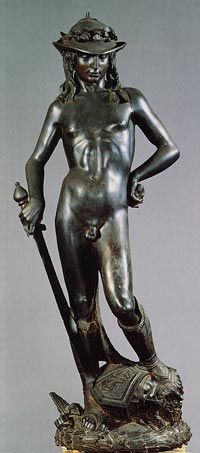
Donatello's David, bronze. This is one of the most famous pieces of Italian Renaissance sculpture. David slaying Goliath is one of the symbols of Florence.
The sleekly sensual depiction of the adolescent David, who stands in a languid pose, his left foot carelessly resting on Goliath's severed head, is remarkable for its naturalism. Donatello departed, however, from familiar images of David by presenting him nude, in the manner of a classical ephebe or slim, pre-pubescent boy. The unusual representation of the David, departing as it does from the biblical text and from classical forms of heroism, suggest that Donatello intended to convey more than just the narrative of David and Goliath. This lead to recent interpretations of the figure's purported androgyny, his sexuality and his homoerotic charge. |
| |
|
|
|
|
|
|
|
| |
|
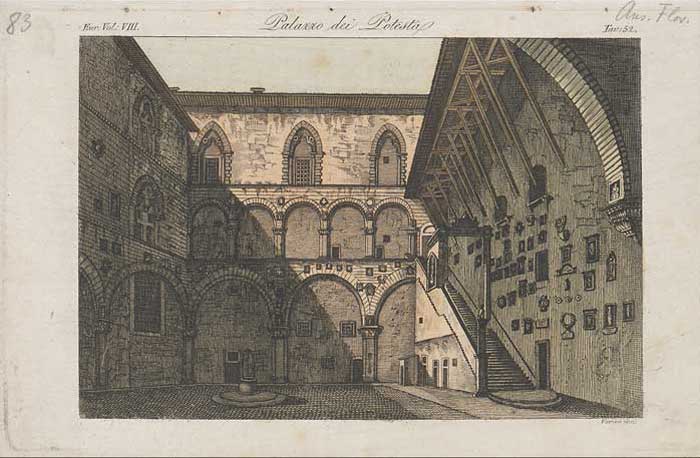 |
Antonio Verico (engraver), Inner courtyard of the Bargello, first half of the 19th century, handcoloured copper engraving, 15.1 x 23.2 cm
|
Perseus holding the head of Medusa (1545-1554) by Benvenuto Cellini is a late Renaissance masterpiece in the Italian Mannerist style. The sculpture is located in the Loggia dei Lanzi in the Piazza della Signoria in Florence. For the four niches of the marble carved base, Cellini created four mythological figures related to the Perseo’s myth. The originals of the base are preserved at the Bargello Museum.
|
| |
|
|
|
|
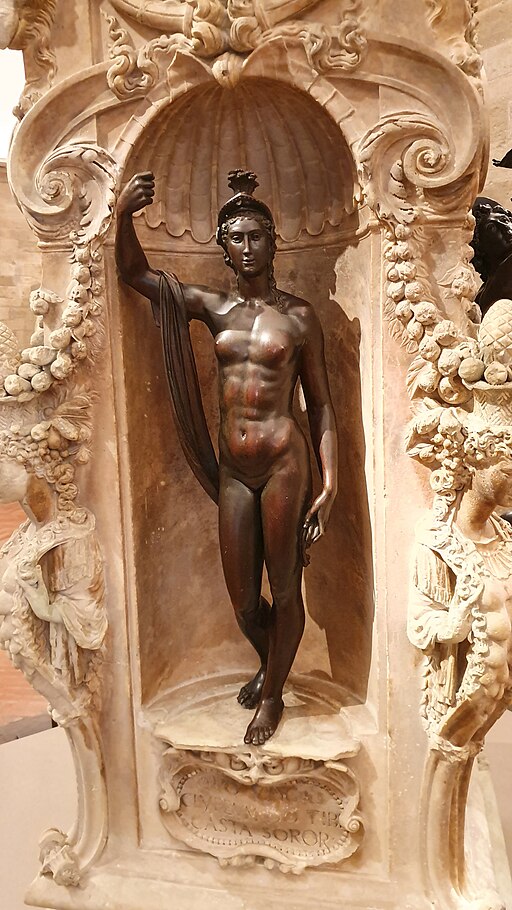 |
|
 |
|
 |
Benvenuto Cellini, Minerva, Museo Nazionale del Bargello, Firenze |
|
Benvenuto Cellini, Jupiter, Museo Nazionale del Bargello, Firenze |
|
Benvenuto Cellini, Danaea, Museo Nazionale del Bargello, Firneze |

Benvenuto Cellini, Mercurius, Museo Nazionale del Bargello, Firenze |
|

Donatello, Marzocco, 1418-20, pietra serena, Museo del Bargello, Firenze |
|
|
| |
|
|
|
Giambologna, Mercurio, Museo azionale del Bargello, Firenze |
Offerings Presented to the Baptistery: The Bargello Cassone
|
 |
Giovanni Toscani, Cassone Showing Presentation of the Palio to the Baptistery, Bargello Museum, Florence,
|
The Bigallo Madonna della Misericordia
|
|
|
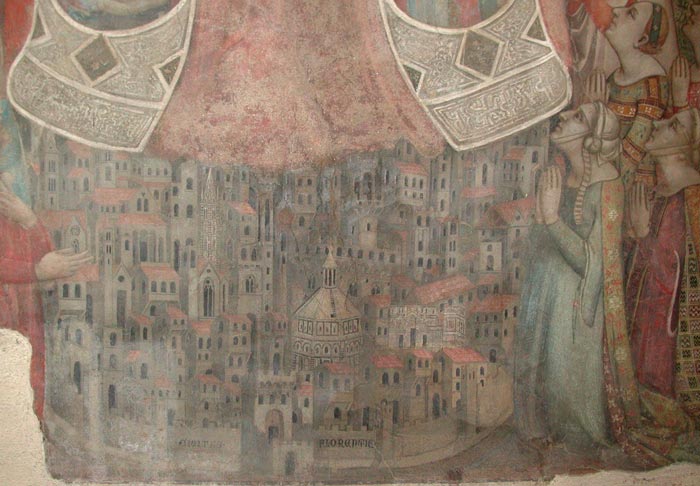 |
The Bigallo Madonna della Misericordia is depicted with the oldest known view of Florence, from 1352, including the Baptistery and an interesting view of the Cathedral during the construction of Santa Maria del Fiore. The old cathedral of Santa Reparata was still standing so that here we can pick out its saddle roof, two belltowers and lateral single light windows. Parts of Giotto's Belltower and the facade of Santa Maria del Fiore, as it had been conceived and left by Arnolfo at the time of his death in 1302, can also be seen.
|
The National Museum has its setting in one of the oldest buildings in Florence that dates back to 1255. Initially the headquarters of the Capitano del Popolo (Captain of the People) and later of the Podestà, the palace became, in the sixteenth century, the residence of the Bargello that is of the head of the police (from which the palace takes its name) and was used as prison during the whole 18th century.
Situated on the corner of the piazza of the Duomo and via Calzaioli, the mid-14th century Loggia del Bigallo has been a small museum since 1904. Even from outside, you can admire the frescoed building, but heading inside will give you a chance to see the much deteriorated but famous fresco of the Madonna della Misericordia, an image of the Virgin Mary with her cape encompassing her devotees (in this case the entire city) who are surrounded underneath and around her. The Bigallo Madonna is depicted with the oldest known view of Florence, from 1352.
Since 1998 the Loggia del Bigallo has been run by the Museo of the Opera del Duomo. Its beginnings, however, were as the main seat of the Misericordia, a catholic confraternity founded in Florence in the 13th century to help those in need, which at the time consisted of mostly people affected by the Plague.
The Madonna of Mercy, painted by the Bernardo Daddi school in 1342, is one of the most important keys for unlocking the vocation and for deepening the meaning of Florence. The Madonna wears a crown like that of the Empress Matilda, with the saving Tau in blood, and it is she who protects the city with the weapons of the acts of mercy as Jesus had listed them in the Gospel, these acts being given in the medallions of her mantle that contain these words.
Art in Tuscany | Madonna della Misericordia | Madonna of Mercy
|
|
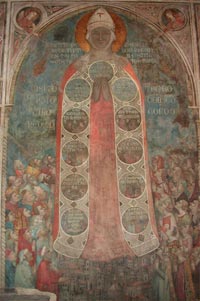
The Madonna della Misericordia, an anonymous 14th century fresco in the Bigallo, Florence. |
|
|
| |
|
|

The hidden secrets of southern Tuscany | Podere Santa Pia
|
 |
Podere Santa Pia is an exclusive villa located in a beautiful hilly environment about 1 km from the medieval village of Castiglioncello Bandini, and overlooks a valley characterised by all the elements of the Tuscan landscape: vineyards, pastures, small forests, wheat fields, olive groves and downey oaks.
|
| |
|
|
|
|
|
| |
|
|
|
|
On December 10th 1479, a fugitive of the previous year’s Pazzi Conspiracy — an ill-starred attempt by the Pazzi family to overthrow the Medici — was hanged in Florence.
The Pazzi conspiracy was the most dramatic of all political opposition to the Medici family. The conspiracy was led by the rival Pazzi family of Florence.
In foreign politics Lorenzo made a disastrous error in the 1470s when he attempted to prevent Pope Sixtus IV from establishing a power base in the Romagna. This led to the Medici bank’s loss of the papal account and a conspiracy between members of the pope’s family and the Florentine Pazzi family to overthrow Medici rule. In April 1478 the Pazzi assassinated Lorenzo’s brother Giuliano but failed to kill Lorenzo, and the insurgents, denied support by the citizens, were captured.
Bernardo di Bandino Baroncelli (1453-1480) was a banker for the Pazzi, and one of the Pazzi conspirators who attempted to murder Lorenzo de' Medici and his brother Giuliano. He grew up learning to hate the Medici for the exile of his cousins. As one of the men whom Jacopo de' Pazzi had hired to kill the Medici brothers, he was the one who delivered the first blow to Guiliano. Baroncelli was later captured while attempting to flee to Constantinople, but he managed to escape to San Gimignano. There, Baroncelli was assassinated by Ezio Auditore da Firenze. Moments before his death, he was evidently becoming paranoid of Ezio and Lorenzo, and was found muttering to himself about how to stay safe. He fled upon catching sight of Ezio, but was nevertheless chased down and assassinated.
A Florentine representative quickly sailed for the Ottoman capital to make the arrangements, and returned with the hated Bandini on Dec. 24. Five days later, he was hanged over the side of the Bargello.
Florentine native son Leonardo da Vinci sketched the hanging man (the sketch is now in the Musee Bonnat), diligently noting his clothing.
The conspirators, Francesco de' Pazzi, Bernardo di Bandino Baroncelli, Archbishop Salviati, Vieri de' Pazzi, Messer Jacopo de' Pazzi, Antonio Maffei and Stefano de Bagnone, were depicted in a painting by Sandro Botticelli on either a wall of the Bargello or a wall of the Dogana, part of the government-complex. Rodrigo Borgia, the Pope Alexander VI pressured Florence to remove these lifelike pictures, and they were eventually destroyed in 1494.
Art in Tuscany | The conspiracy
|
|
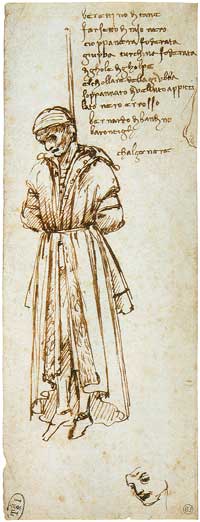
Leonardo da Vinci, drawing of a hanged
Pazzi conspirator Bernardo di Bandino Baroncelli, 1479 |
| |
|
|
 |
|
|
Walking in the Bargello Neighbourhood
The tour starts in the Piazza della Signoria, the very heart of Florence. Head towards Palazzo Vecchio, move behind the statue of Hercules and Cacus by Baccio Bandinelli, and walk up the seven or eight steps skirting the fašade of the palace itself. If you look closely at the flattish stone almost on the corner of the palace about four courses up, you cannot fail to note the rather roughly carved face of a man. Legend has it that Michelangelo, who frequently crossed this square on his way to and from home, was often importuned by a local lunatic. One day his patience ran out, so while he pretended to listen to the lunatic as he leant against the wall of the palace, he amused himself by carving the man's likeness on the stone behind his back. Ever since that day, this face has been known to Florentines as L'Importuno. Carrying on past the main door to the palace, you will reach the Fountain of Neptune. Head diagonally to your right across Piazza della Signoria, walking past the equestrian statue of Grand Duke Cosimo I by Giambologna; take Via de' Magazzini out of the northeast corner of the square. The street ends in a small square. On the left you can see the fašade of the chapel of San Martino dei Buonuomini, containing 15th century frescoes showing the good works performed by the voluntary order whose chapel this was. Incidentally, it takes the place of the earlier church of San Martino in which Dante was married to Gemma Donati, the remains of the facade of the earlier church can be seen in the Canto alla Quarconia, round the back of the present church and just beyond a tavern, the Birreria Centrale.
Walking in Tuscany | Walking in the Bargello Neighbourhood
|
| |
|
|
| |
|
|
| |
|
|
|
| |
|
|
|
| |
|
|
|
| |
|
|
|
| |
|
|
|
| |
|
|
|
![]()
![]()
![]()
![]()
![]()










